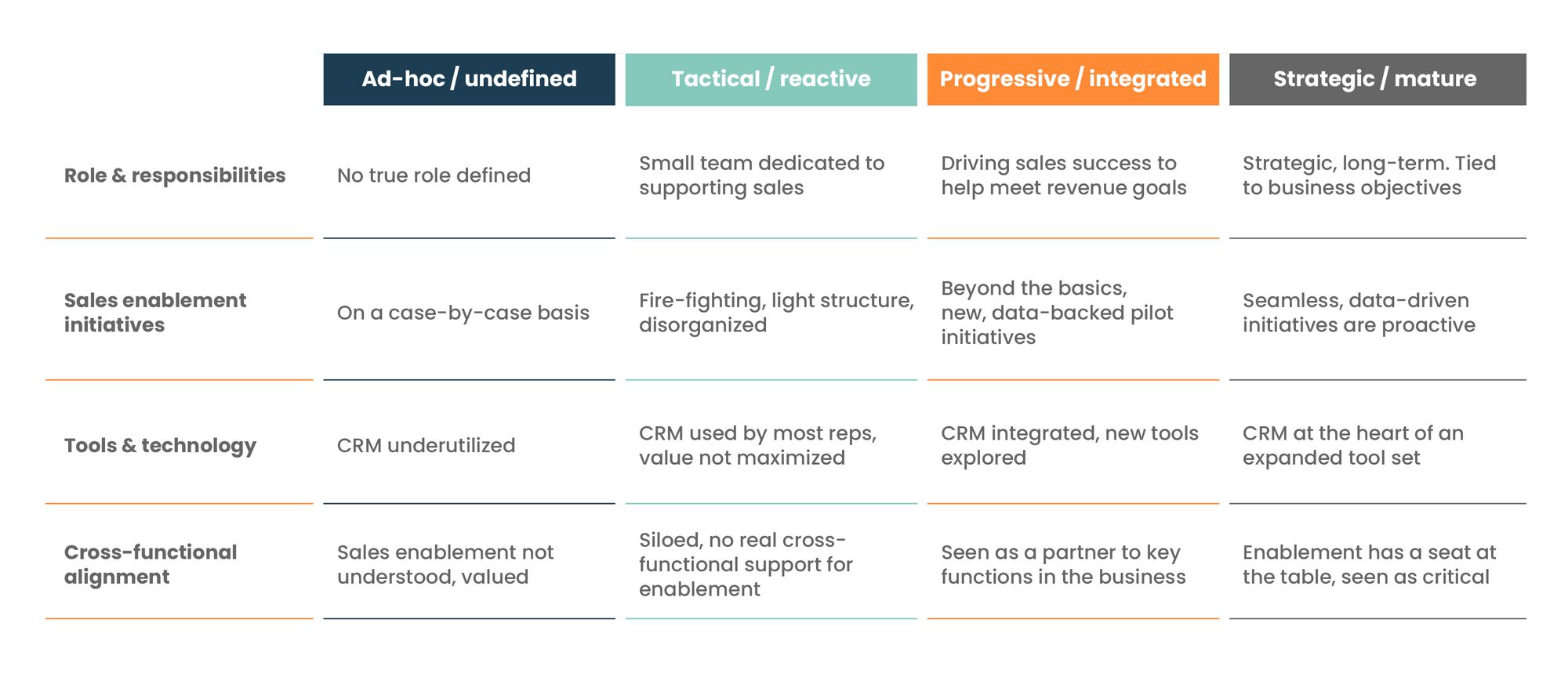Sales enablement is undeniably a fast-growing discipline. A decade ago, if you had mentioned sales enablement, most people would have given you a puzzled look.
Now? It’s a need-to-have in ambitious organizations wanting to drive their sales teams to greater success.
Our Sales Enablement Landscape Report 2022 found that 60.9% of our respondents’ enablement teams were established less than three years ago.
That surge in popularity and recognition has resulted in a wave of conversation about sales enablement maturity and how one should measure the stage at which their sales enablement function is at.
The issue with that is that sales enablement can vary greatly in roles and responsibilities across different sales organizations.
Across the web, you’ll find maturity models with four stages, five stages, and even six stages – and often the stages will be named slightly differently.
In this article, we’re going to look at:
- What is a sales enablement maturity model?
- Why a maturity model can help your sales enablement team.
- The maturity stages.
- Cheat sheet.
While no model is perfect – everyone has differing views and opinions on enablement’s maturity – this article broadly outlines the key stages and what separates them from each other.
Let’s examine it in more detail. 👇
What is a sales enablement maturity model?
As we stated earlier, different sales organizations will be at various stages of their sales enablement journey.
An enablement function that’s been around for more than 7 years (9.5% of our aforementioned report’s respondents) is much more likely to be an established, strategic part of the organization than a brand-new, one-person team.
A maturity model or framework gives you the opportunity to look at your sales enablement team in the big picture.
It outlines what sales enablement looks like at each stage of maturity, and how it interacts with the rest of the business as it matures.

How can a maturity model can help your sales enablement team?
What makes a maturity model useful is that you can use it to plot where you are on your enablement journey, and use it to guide a long-term vision for your team.
As your enablement team matures, your interactions with marketing, sales, sales operations, and senior leaders in your organization will change and evolve. Having a maturity model helps you evolve in the right direction.
The ultimate goal for a sales enablement team is usually to become a strategic function in the organization, moving from ad-hoc fire-fighting or tactical pieces of training to creating data-driven, strategic initiatives to back up business objectives.
This can’t happen overnight, so it’s important to have a maturity model or framework to help you track your progress and set goals.

Sales enablement maturity stages
Now, we’ll look into the stages – remembering that the names and definitions aren’t set in stone and can vary depending on who you ask.
Stage 1: Ad-hoc/undefined

Often, you’ll see ad-hoc and undefined maturity stages listed separately, as stage one and two. For this model, we’ll combine them as they’re quite similar.
At this early stage of maturity, often seen in high-growth startups, enablement doesn’t have truly defined roles or responsibilities and often won’t have its own dedicated team.
The goal is to try and support the sales team but the structures aren't in place to do that effectively.
Training is done on a case-by-case basis, with little proactive effort – not necessarily out of neglect, but because the time and resources aren’t there to implement solid enablement processes.
Cross-functional collaboration is critical to successful enablement but, at this stage of maturity, there’s no clear path to working with marketing, sales ops, and other stakeholders.
Regarding the tech stack, there isn’t much in place at this point. A customer relationship management system (CRM) might be in place, but it’s not properly aligned to the organization’s sales process or to maximize reps’ sales performance.
Stage 2: Tactical/reactive

At this stage, we start to see a better-supported sales team, but there’s still a lot of room to grow.
Sales leaders and the organization as a whole should have a somewhat decent understanding of what enablement is and what it brings to the table. There will more than likely be a dedicated enablement team, even if it only consists of one person.
Training might have some structure, such as being periodic, but it’s not supported by data or individualized to sellers’ strengths and weaknesses.
Sales content and collateral exists, but is probably disorganized and accessing it is not as efficient as it should be – meaning less time spent selling.
Onboarding processes are formally set up, but again, are lacking efficiency.
The tech stack will start to come together at this point, with the CRM having a good level of attainment among reps.
A basic level of metrics-tracking will take place too; however, it’s likely with an aim of proving the value of enablement more than truly understanding rep issues.

Stage 3: Progressive/integrated

This stage is when we see sales enablement really come into its own. When enablement reaches a progressive stage, it starts truly driving reps towards their sales objectives and making a claim for a seat at the table with the organization’s leaders.
Collaboration with other functions, such as marketing and product marketing, should be happening (on the creation of up-to-date content, for example) and siloes should be limited – with other departments understanding of enablement’s value and willing to support.
Enablement is a partner to these departments.
Training starts to look beyond just reactive and routine pieces, and pilot initiatives should be explored and backed by data.
Repetitive processes like onboarding and SKOs should be continuously iterated upon and improved based on data and feedback in order to drive improved sales performance.
When it comes to tech stack, the CRM should be integrated with your sales methodology, and the stack can start to expand into content management systems (CMS), learning management systems (LMS), conversational intelligence (CI) tools, and more.
Processes, automations, and integrations should be clear to team members.
Stage 4: Strategic/mature

This fourth and final stage of maturity is the ideal state for an enablement team to be in. Sales enablement is an established and trusted consultant to the organization that acts in a strategic manner in order to align with the business’s objectives in the long-term.
Sales enablement not only has a seat at the table, but is a major player – in some cases directly reporting to the C-Suite (to a Chief Revenue Officer, for example). Beyond just being considered a partner to other functions, sales enablement is seen as a critical driver of business success and revenue growth.
Onboarding and continuous development are seamlessly linked, with data-driven insights allowing for specialized group and individual coaching.
Content is organized and easily accessible in order to increase rep selling time. All of this is tied into a proactive, long-term sales enablement strategy.
The tech stack should be fully integrated, with a CRM at the heart of it and data reporting available from a single source of truth.
Other sales enablement tools such as CMS, LMS, CI, and artificial intelligence and automation tools should all be focused on maximizing rep selling time and ensuring the sales team is in the ideal position to sell and develop their selling skills.
Cheat sheet
Here, you’ll find a quick visual guide with the key points to remember when it comes to sales enablement maturity stages.

Summary
Wrapping up, we can see that a sales enablement maturity model is useful as it allows you to track your team’s sales enablement journey – and the progress you’ve made in growing, maturing, and developing.
From stage one, where your enablement is very ad-hoc and might not even have a dedicated team, to stage four (or five, depending on who you ask!), a mature, strategic enablement team that has a seat at the table and is a major player in your organization.
The State of Go-to-Market Survey
Do you want to be part of the future of Go-to-Market strategy?
Help us lift the lid on what 2023's Go-to-Market trends will be by filling out the State of Go-to-Market Survey.
We'll be asking:
👑 How Go-to-Market leadership is changing.
💵 What a successful GTM budget looks like.
🧗♂️ The biggest challenges for GTM professionals.
With your insights, we can deliver a report that enables Go-to-Market teams across the globe to get the buy-in and resources they need.





